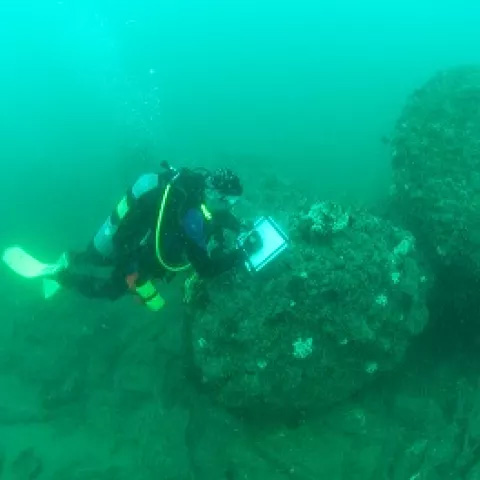The expertise and knowledge of BSEE scientists is often called upon when scientific research is being conducted on the OCS, and the exploration of Monterrey Shipwreck Site 15577 is the latest example of this collaboration.
In 2011, Shell Oil conducted a sonar survey of one of their lease areas in the Gulf of America when they discovered what appeared to be a shipwreck on the seafloor 4000 feet below. Shell notified BOEM and BSEE of the discovery, per regulations, and the shipwreck site was designated as site 15577. One year later, in April 2012, the National Oceanographic and Atmospheric Administration (NOAA) along with BOEM, BSEE, and other government and industry partners, joined together on a project to explore shipwreck sites in the Gulf of America. One of the sites selected was site 15577. The NOAA ship Okeanos Explorer conducted the first reconnaissance of the site. The ROV dive on the shipwreck lasted just over two hours, collecting invaluable high-definition video.
The data collected by Okeanos Explorer's brief visit was met with great interest from archaeologists and historians across the nation. The artifacts and vessel remains suggest the site may date to the first half of the nineteenth century, making it one of the more fascinating shipwrecks discovered in the Gulf of America to date. The site, well preserved and remarkably undisturbed, is from a critical period in history when new nations were forming in the New World at the end of the Colonial era and the Gulf was opening to global trade.
The considerable interest in Monterrey Shipwreck Site 15577 has resulted in a partnership between the Meadows Center for Water and the Environment at Texas State University and the Ocean Exploration Trust (OET). They are leading an expedition to Site 15577 on OET's E/V Nautilus from July 18 - 25, 2013. Chris joins a team of scientists for a week using the ROV Hercules to carefully document, map, video, and photograph the site, and recover a small number of artifacts for conservation and analysis. Information obtained during this investigation will help place the vessel in its historical and cultural context. Science partners in this endeavor include the Meadows Center, NOAA, BSEE, BOEM, , State of Texas, University of Rhode Island, State of Maryland, Texas A&M Conservation Research Laboratory, OET, and others.
Live video from the seafloor and more information about the 2013 expedition can be found at Nautilus Live and Exploration Now.


